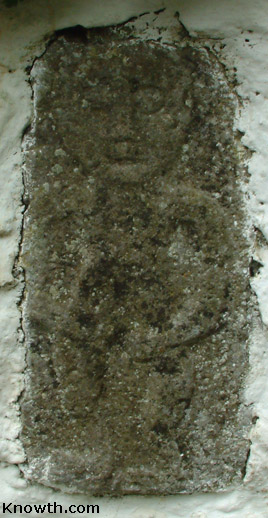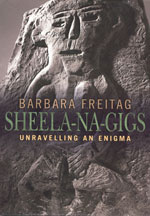Sheela-na-gigs | Power to Make Irishmen Blush
Museum accused of hiding away explicit 'hag or goddess' figures from medieval churches by Denis Staunton Ireland's familiar, fiery cocktail of sex and religion is fuelling an extraordinary argument
about naked women exposing themselves. The women are
sheela-na-gigs,
sexually explicit medieval stone carvings usually found above church doorways, which the
National Museum of Ireland is accused of hiding away.
Ireland's familiar, fiery cocktail of sex and religion is fuelling an extraordinary argument
about naked women exposing themselves. The women are
sheela-na-gigs,
sexually explicit medieval stone carvings usually found above church doorways, which the
National Museum of Ireland is accused of hiding away.
Eamonn Kelly, keeper of antiquities at the museum, insists that, although only two are currently on display, all the museum's 13 examples have been exhibited at one time or another. Mr Kelly, who has just published a book about sheela-na-gigs, dismisses the suggestion that his exhibition policy is influenced by a prudish aversion to the carvings, which almost always depict naked women clutching their genitalia.
'When the whole pre-historic collection was taken off display during rebuilding work, we didn't have a single complaint. But we're inundated with letters about the sheelas, demanding that they should all be exhibited. People think they're hidden in the crypt wrapped in nappies, which is just laughable,' said Mr Kelly.
But this is not good enough for Jack Roberts, and English-born antiquarian who has studied sheela-na-gigs since he moved to Ireland more than 20 years ago. He perceives a conspiracy to suppress a full debate about the historical significance of the objects, led by the Roman Catholic Church and supported by the academic establishment. "They are being hidden away. There is no question about it. Even the two on display are tucked away in a corner. They don't mix with the idea of Christianity the Church wants to promote. I've been told by priests that I shouldn't highlight this aspect of Christianity, but I just tell them that the Church highlighted these objects by placing them over church doorways," said Mr Roberts.
The origin and function of sheela-na-gigs is the subject of fierce controversy. Experts cannot even agree on what their name means. Mr Kelly believes it probably translates as either 'the hag of the breasts' or 'the old woman on her hunkers'. He said: 'The term "sile" in Irish refers to an old woman, and it was almost certainly taken to Australia by Irish convicts and emigrants and gave rise to the Australian term "Sheela".'
He believes the carvings were imported to Ireland by the Normans in the twelfth century and served as warnings against the perils of sexual lust. The Irish may have interpreted them in their own way later, linking them to pre-Christian fertility cults.
Mr Roberts, along with archaeologists such as professor Etienne Rynne from the University of Galway, claims they are part of an older Irish tradition and insists that, far from warning against female sexuality, they celebrate it in a manner similar to goddess cults in other parts of the world.
'It's worth noting that a lot of the earliest examples are found on churches and abbeys associated with the females branch of the Church. Ireland had a dual form of Christianity, with a female church led by figures like St Bridget operating parallel to the male church,' he said.
Interest in sheela-na-gigs has been growing steadily in recent years and the National Museum of Ireland is sending four examples to the University of Miami next year for a special exhibition. Similar carvings can be found on churches in England, Scotland and Wales, but not in such large numbers as in Ireland, where more than 100 survive. T-shirts with sheela-na-gigs are among the most popular items in the National Museum of Ireland shop.
A Sheela-na-gig was stolen from Kiltinan Church in Co Tipperary in 1990, prompting the local historical society to offer a reward for information leading to its return. Despite an international search involving Interpol, it has yet to be recovered. An attempt to steal another the following year was foiled by a sting operation organized by the Gardai and the FBI, with an FBI agent posing as a wealthy Boston patron.
The law governing the sale of antiquities has since been tightened and Mr Kelly is confident that the thieves have turned their sights elsewhere. Ireland has the strictest laws in Europe governing the sale of antiquities. Nobody would ever be able to sell a sheela-na-gig, he said.
Mr Roberts claims that vandalism is the real problem because most remaining sheela-na-gigs are in remote, misty corners of the country and are almost impossible to protect. He blames religious zealots for most of the damage, but predicts that as Irish society changes the sheelas will reassume their rightful status as a cherished national symbol. 'It's happening already. In the art world, women artists are turning to sheela-na-gigs for inspiration. A new generation of Irish people wants to reclaim these dangerous, subversive objects,' he said.
Sheela-na-Gigs - Unravelling an Enigma by Barbara Freitag.
 For
centuries Sheela-na-gigs led a quiet existence on churches all over the British Isles.
When they were brought to scientific attention in Ireland, some 160 years ago, their discovery, understandably, was not greeted with an unqualified welcome.
For
centuries Sheela-na-gigs led a quiet existence on churches all over the British Isles.
When they were brought to scientific attention in Ireland, some 160 years ago, their discovery, understandably, was not greeted with an unqualified welcome.
After all, what were these carvings of naked females doing on medieval churches? And not only naked, but openly displaying their genitalia. Embarrassed clergymen and high-minded churchgoers physically removed and hid or destroyed the offensive figures. Archaeologists tended either to ignore them altogether or to label them as lewd, barbarous or repulsive.
Purchase at Amazon.com or Amazon.co.uk
Boyne Valley Private Day Tour
 Immerse yourself in the rich heritage and culture of the Boyne Valley with our full-day private tours.
Visit Newgrange World Heritage site, explore the Hill of Slane, where Saint Patrick famously lit the Paschal fire.
Discover the Hill of Tara, the ancient seat of power for the High Kings of Ireland.
Book Now
Immerse yourself in the rich heritage and culture of the Boyne Valley with our full-day private tours.
Visit Newgrange World Heritage site, explore the Hill of Slane, where Saint Patrick famously lit the Paschal fire.
Discover the Hill of Tara, the ancient seat of power for the High Kings of Ireland.
Book Now
Home
| Visitor Centre
| Tours
| Winter Solstice
| Solstice Lottery
| Images
| Local Area
| News
| Knowth
| Dowth
| Articles
| Art
| Books
| Directions
| Accommodation
| Contact

